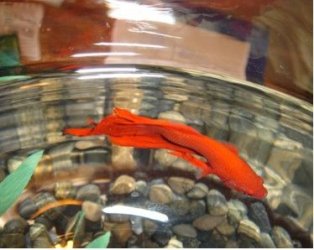Red is gorgeous!! Congratulations! And your bowl is very nice. 2 gallons + is a good size for bettas, IMO.

I would also suggest you invest in some water testing kits. Especially ammonia and pH - these two would be the most important in a non-filtered tank. Get the tester kits that use drops (2 bottles for the ammonia and 1 bottle for the pH) instead of the dipsticks, which often is not as accurate.
Anyway... testing daily for ammonia in the water (which comes from fish poop, pee and uneaten food) will determine how often you should change your water. As soon as the ammonia rises to even .25ppm (you get a chart with the tester kits to determine this) - change the water... and keep note of how many days inbetween. It's best to not even let it get to 0.25 so changing the day before you noticed the increase is best. When your betta is exposed to ammonia and other byproducts (like nitrite and high nitrates) - it can start to cause all sorts of problems and diseases - especially if he was predisposed to anything prior to your taking him home.
pH is important as sometimes water sources pH fluctuates. City tap water does change - especially in warmer weather. If you use bottled water - that can sometimes change too... esp if different brands are used. It's just good to know... high swings can cause irritation in the fish.
The air bubbles you see when you first add water is called nitrogenous (I think that's what it's called) supersaturation... or air bubbles. It's good to let the water sit for a few hours to let them dissipate. Stirring the water or using a never-used/never seen soap turkey baster to "blast" them is good before adding the fish. When these bubbles pop - it creates gas pressure in the water... can often lead to bloating in the fish, pop-eye or even dropsy or swim bladder. I've had this in my tanks - but it never caused problems in my fish (knock on wood) - but I think if they're constantly exposed to these bubbles with every water change... you may find a problem.
I'm not familiar with the Stress Coat - but an excellent dechlorinator is Prime by Seachem. It removes the chlorines, chloramines and protects their slime coat.
A thermometer was mentioned to have on your tank - to monitor the water temp - very important. Bettas optimum temp range is 75-80F. If you find that your room temp is too low - like was suggested - try moving your betta's tank to a warmer part of your home - but keep away from direct sunlight and drafts. A heater would work - but in a smaller bowl - it might be hard to not overheat... so please get a thermometer (there's ones that stick on the outside - they work well). Many have used the 7.5watt heater "pads" in their smaller bowls.... I'm not sure how good they are though.
You will need a lid - even if you keep the water level down a bit - many have found their bettas can jump quite high and end up on the floor. Fine/breathable netting - you can get by the yard/meter at a fabric store and is very inexpensive. A paper plate with small holes is also a good temp fix till you find something more suitable - but I know it won't look so nice on your bowl.
Sorry for the long read... I'm still pretty new to the world of bettas and fish keeping - this is all stuff I've learned in the last couple of months... and thought it was worth passing on! Good luck with your little guy! He's adorable!!!!!




 /z7.invisionfree.com/Uniquebettas/in...p?showtopic=164
/z7.invisionfree.com/Uniquebettas/in...p?showtopic=164



 You could probably use like a paper plate as a temp cover for the top until you can find something permanent.
You could probably use like a paper plate as a temp cover for the top until you can find something permanent.

